JOKER WEEK: Birthday boy STEVE ENGLEHART delves into the Clown Prince of Crime’s terrifying psyche…
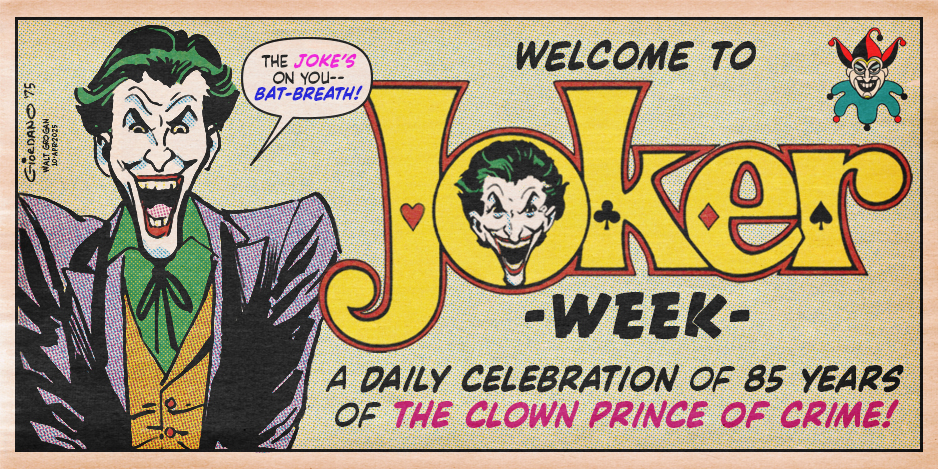
—
Welcome to JOKER WEEK! One of the greatest characters in comics history debuted 85 years ago, in Batman #1, on April 24, 1940 — and we’re celebrating with a series of features saluting the Clown Prince of Crime, just like we did with CATWOMAN WEEK. For the complete index of JOKER WEEK features, click here.
—
UPDATED 4/22/25: This first ran in August 2020 as part of a lengthy, 10-part interview series with Steve Englehart (fuller explanation below). We’re reprinting it today for three reasons: 1) Englehart is turning 78. 2) It’s JOKER WEEK! 3) This segment and the rest of the installments will all be included in TwoMorrows’ upcoming Marshall Rogers: Brightest Days and Darkest Knights, by Jeff Messer and Dewey Cassell, one of the year’s most anticipated books on comics. You can see a whopping 40-page preview here, complete with ordering info. Right on. — Dan
—
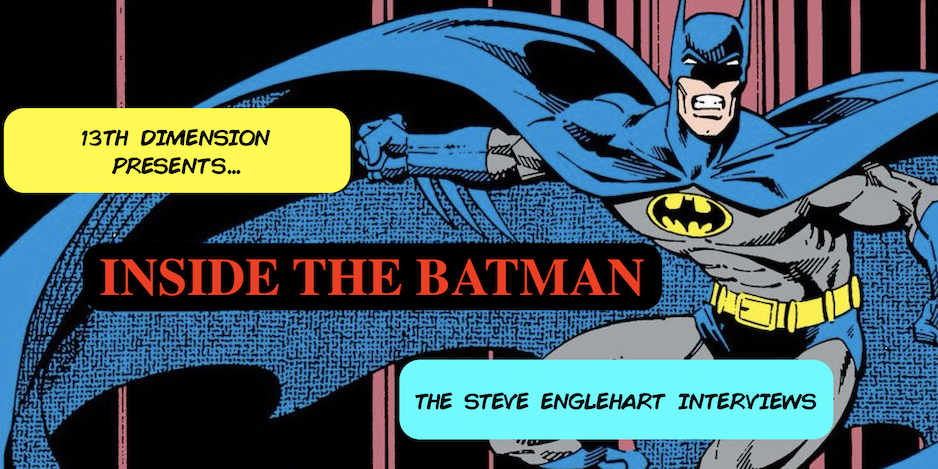
Welcome to INSIDE THE BATMAN: THE STEVE ENGLEHART INTERVIEWS, an issue-by-issue exploration of the greatest Batman story of all time — Steve Englehart and Marshall Rogers’ seminal 1977 Detective Comics run. The complete story has finally been collected for the first time in hardcover — and in the way Englehart envisioned it — in Tales of the Batman: Steve Englehart. With the book newly released, the time is perfect to go back and look at the story from every conceivable angle. Each weekend this summer, we’re diving into a single chapter of the 8-issue saga, with full commentary by Englehart himself — the most complete analysis of the landmark storyline ever published. For the INDEX of individual entries, click here.

So far, we’ve covered how Steve Englehart landed the gig, what he set out to accomplish, what his overarching thoughts are on Batman and the Joker, the Darknight Detective’s sex life, the change in art teams from Walt Simonson and Al Milgrom to Marshall Rogers and Terry Austin and how he structured the story. (Click here.) We’ve also explored the story’s first six issues — Detective Comics #469 (click here), Detective #470 (click here), Detective #471 (click here) and Detective Comics #472 (click here), Detective Comics #473 (click here), and Detective Comics #474 (click here), which gave us Silver St. Cloud, Rupert Thorne, Dr. Phosphorus, the return of Hugo Strange after nearly 40 years, the Penguin and the reclamation of Deadshot.
Now, we’re nearing the end — and with Detective Comics #475’s The Laughing Fish!, we get not only the beginning of a brilliant arc’s climax, we get the first part of one of the greatest Joker stories ever told.
But first, we’re going to tie up a couple of very important loose ends from ‘Tec #474 — because they feed directly into the opening of #475.
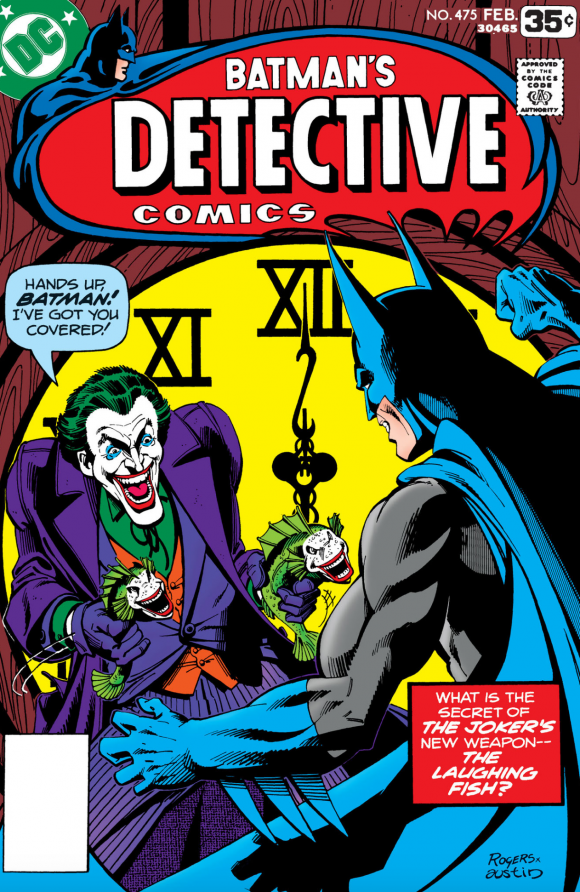
Dan Greenfield: We are now finally up to the last two issues — and the Joker.
Steve Englehart: We are but I got to say before we get away from Detective #474, that this is where Silver recognizes the Batman.
Dan: Yes, this is where Silver figures it out. You left the clue in the second issue where she noticed Bruce’s hair was wet, and all along she’s been very intent on trying to get underneath, get behind his eyes, for lack of a better term. This is the big payoff, where she sees him and she knows it. How did it all come together, and was that part of the plan all along?
Steve Englehart: Yeah, it definitely was, and that’s the whole thing about making her a real person and a real girlfriend. I thought to myself, if you’re sleeping with this guy on a regular basis, you know him pretty well and you’ve probably been very close to the bottom half of his face quite a lot! And she’s not stupid. She’s intelligent, strong, everything that I wanted her to be. For her to look at him and go, “I know who that is!”
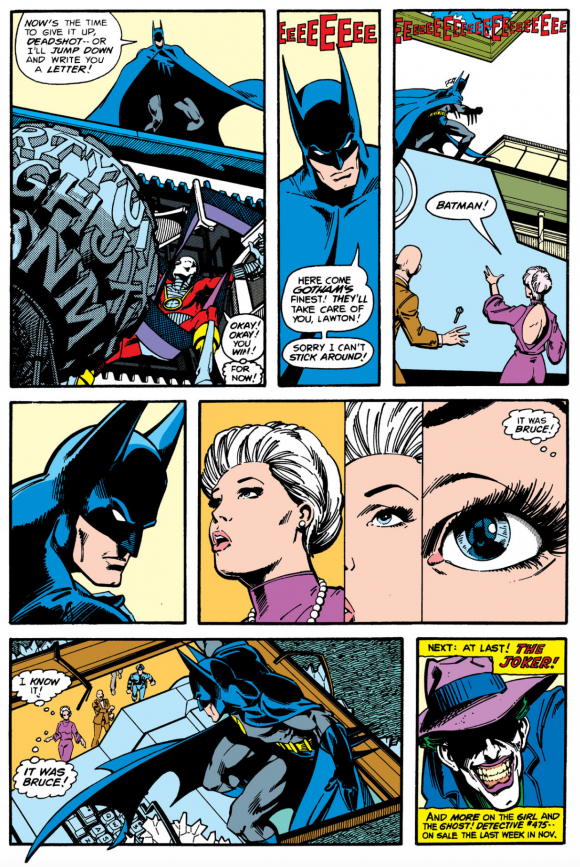
Because we just saw her sitting there in the restaurant staring at him, right? She knows that face. It just seemed sensible to me. So that’s the part about being a real woman with a real sexual relationship that wasn’t just gratuitous or something to make Bruce Wayne look better. She’s not a straw character, she’s got to do something.
The idea that she would recognize him, that came very early. We were heading in this direction, whether I’d blocked it all out or whether I was just sort of shaping it. Silver St. Cloud’s arc began when she noticed that his hair was wet. That to me was kind of liken “Huh, that could lead somewhere.” Then after that it’s like, “Oh yeah, I’m figuring out where that’s going to lead.” So that’s what that is. It’s beautiful artwork. The expression on her face when she looks at him. And the giant typewriter! And we’re at the Weisinger Convention!
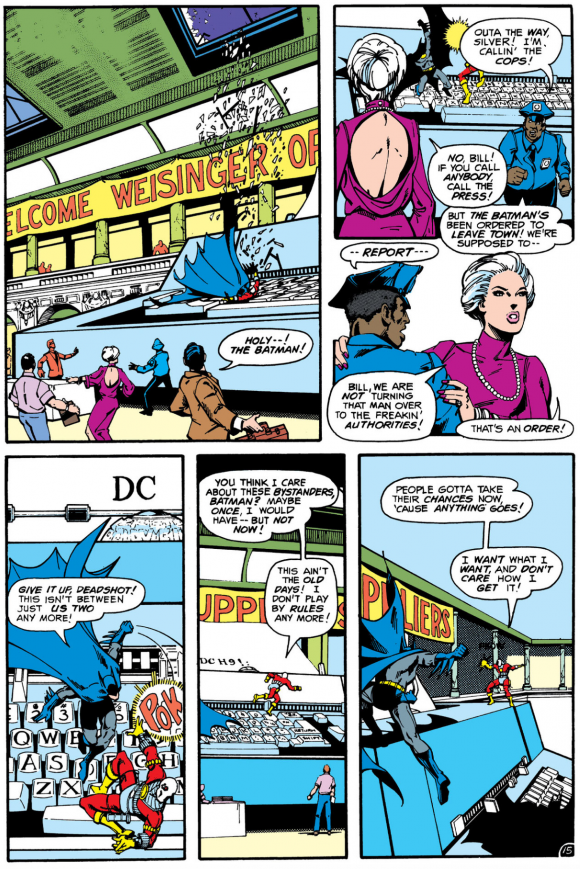
Dan: You threw a lot of creator names in there: There’s (John) Broome, there’s (Dick) Sprang, there’s (Bill) Finger, and there’s (Jerry) Robinson.
Steve: I honor those guys. The fact that I could sit there and go, “I’m going to take all the cool stuff of the last 30 years and then shape it into something that I can be in charge of.” I mean where did I get that cool stuff? That was other people doing stuff that stuck with me.
Personally, I only met Mort Weisinger a couple of times, and he was the big gruff guy with the cigar. A lot of people weren’t big fans of his — I didn’t know him well enough to care one way or the other, but he’s part and parcel of the whole thing and so he gets the shout-out just like Jerry Robinson or the (Gardner) Fox Gardens, all that stuff. The package is brand new, but it’s the same way to me as the silver clouds in front of the moon, it’s all part of the atmosphere and the vibe that’s built up over the years. If I were doing Superman, I wouldn’t do this kind of story. This isn’t a Superman kind of story. But for Batman, ghosts, giant typewriters, all that stuff, it just all seemed to fit together.
In any event, so we get to the next issue (#475). We get one of my favorite scenes of all time, which is when he comes in the window. I’m pretty sure I didn’t say she’s half-dressed but that’s Marshall working with that. I just was exploring where all this would go.
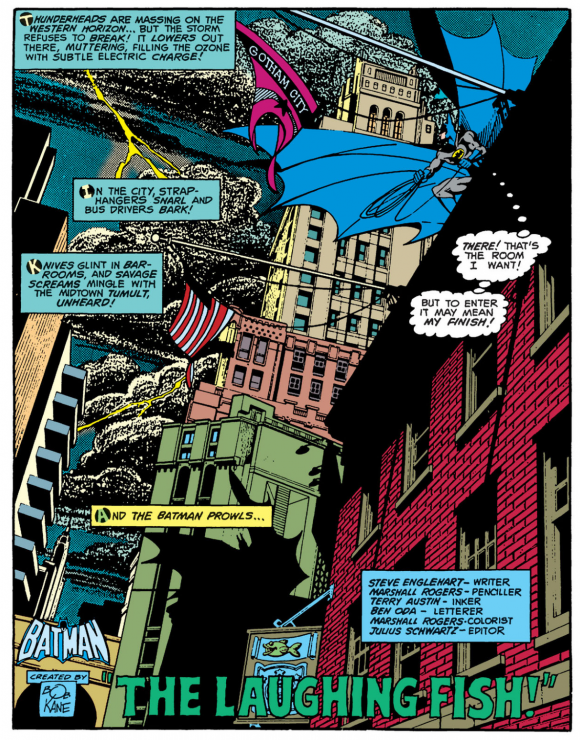
He thinks she knows, but he can’t say so because then that gives the game away if she doesn’t know. And she does know, but she can’t talk to him. Hopefully by this time, we’re invested in these two people, and here they are, they’re like, “Mmmph, this just can’t… this just can’t fit the way it is.” That’s going to lead her where it’s going to lead her.
Again if I didn’t have that extra issue (‘Tec #474), I don’t know that I would have had three pages (to explore that). I mean, in a 17-page book, three pages is a lot of goddamn real estate. I mean if you want three pages, you better justify those three pages. If you don’t have the room, then you’re going to do it in two pages or you’re going to do it however. This scene, just a wonderful scene. I wrote it, so naturally I think it’s well-written — but it’s well-drawn, it’s well-paced, it’s well… it’s just, “Oh man, thank you God! This is everything I could have hoped for.” But I had no reasonable expectations of how I was going to get it.
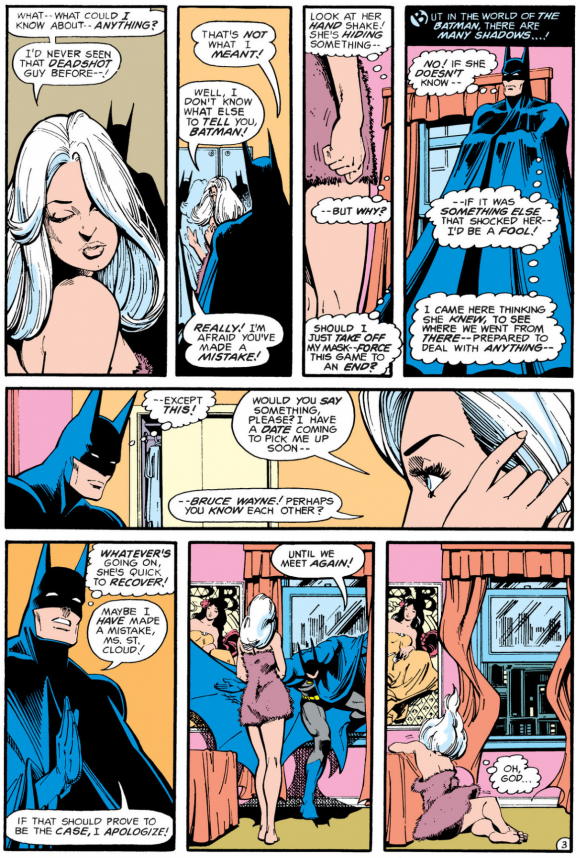
Dan: This is where things come to a head: You’ve got Rupert, you’ve got Silver and this whole back and forth with her and Batman. Then Batman of course has to go and get to work, as it were.
In the same way that you’ve said that you ultimately figured out that you wanted to have her find out who Batman was, was it your intent at the beginning — I know you’ve said repeatedly that you like your stories to sort of grow organically and see where they take you — but was it always your intention to finish with the Joker and have that be the climax of the entire thing?
Steve: Yes. Oh yeah. I mean, you’ve got to build toward a climax. It’s got to come to an end and you want it to be a big end. And there’s nobody bigger than the Joker in the Batman’s world. The fact that it was also headed toward Bruce and Silver, simultaneously, just made it that much richer.
The Joker is the biggest villain. If I’m going to have my seven or eight issues, it’s going to be my entire Batman oeuvre — it’s going to end with the Joker. I’m not going to end with even the Penguin. It’s like, the Joker is The Guy.

Dan: We’ve talked about your thoughts about the Joker and what made yours distinct. But taking it one step further in the actual plot itself — with the MacGuffin, the Joker fish — where did all of that come from?
Steve: Well, in the same way that I thought the Penguin ought to have an actual mystery with actual clues, for the Joker I thought we needed an actual insane plot. But a plot that you can see is insane, but you can follow that he doesn’t. That he’s crazy.
That’s the thing again: We hadn’t seen a really crazy Joker for 40 years at this point. All due respect to The Joker’s Five-Way Revenge! (in Batman #251 by Denny O’Neil and Neal Adams), he was just a dangerous sort of character. We hadn’t seen a crazy homicidal maniac, and that’s where I wanted to get to with him. It hadn’t been there for 40 years, or 35 or whatever it was, but nobody said, as far as I remember, people didn’t go, “Well, what the fuck is this?” They all said, “Oh yeah, that’s the Joker!” Everybody knows that’s the Joker, but comics hadn’t done him forever.
So he comes in, he’s crazy, and exactly why fish? Why laughing fish? I just was sort of noodling, you know, there’s a part of my brain that can become all the different characters. That’s what I like about writing. I can get inside each one of these heads. Getting inside the Joker’s head, I can sort of short circuit my brain a little bit and go well now what is insane?
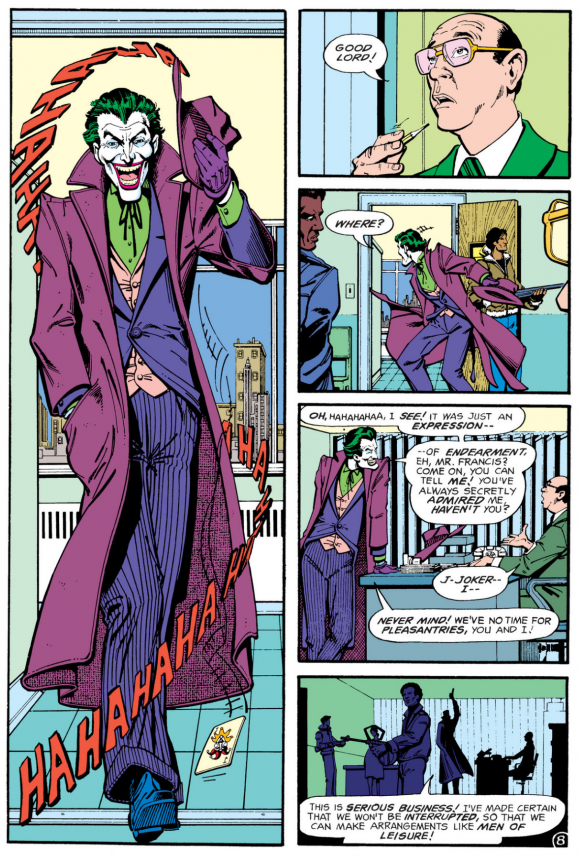
In the next one, Dark Detective II as I call it*, the whole thing about “Vote for me or I’ll kill you,” I mean it’s all just like, this is a madman. This guy’s nuts! But you don’t just go, “Oh yeah, he’s crazy, he does crazy things. No, let’s see what he does, why he thinks that this is all going to work out.”
So you get the wonderful panel of the Joker walking in the room, now an icon. And this whole thing about “I want to copyright fish.” Which just sounds — I mean you laugh, right? It sounds ridiculous. It’s supposed to sound ridiculous. But he thinks he’s going to do it, and he’s going to kill you if you don’t go along with it.
We hadn’t seen that, and I wanted not just for him to say, “Oh yeah, I’m a wacky guy, I wanted to see that. And then he throws his guy in front of a bus, it’s like, this guy’s crazy.
I’ve said it 15 times now, but he hadn’t been like that since 1941, right? Now he’s all of that. This is where all that changed, where all that got re-established and set up for going forward.
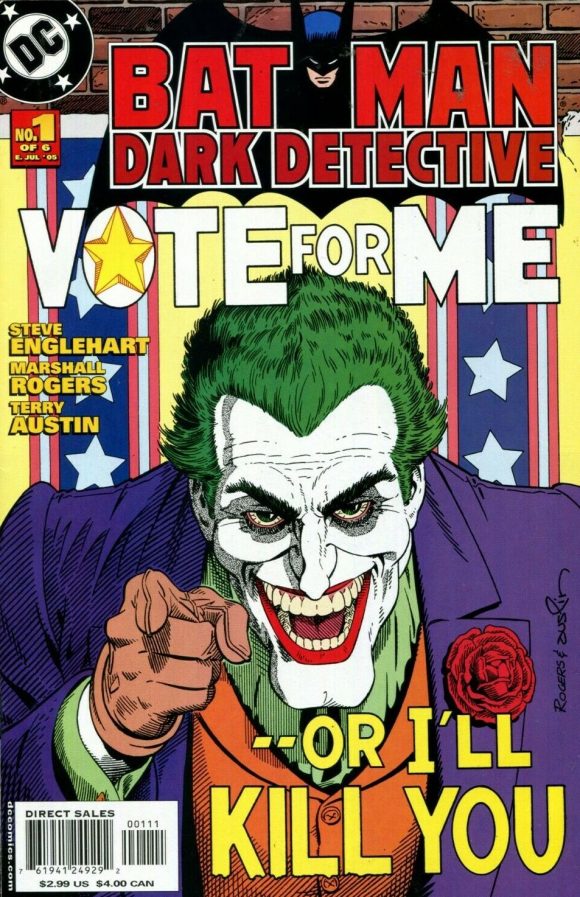
(* Since the full, original arc has no official name that has stuck, Englehart refers to it as Dark Detective. Meanwhile, his 2005 miniseries sequel was officially called Dark Detective, so Englehart considers it to be Dark Detective II.)
Dan: As a side note, did you see the movie Joker?
Steve: I haven’t. I go back and forth about whether I want to see it, because I’m not sure that I — and I’ll say this about The Killing Joke too — I’m not sure that I really want to know how he became the Joker. I like him better as a force of nature. I like him being inexplicable on many levels, so the idea about how comedians got turned into the Joker…
I love Alan Moore, but I was not a big fan of The Killing Joke. That story just did not work on the level that I wanted to see. It’s the same with the movie. It’s now on HBO so it’s there if I want to dial it up.
Dan: I come from the same point of view that you do. I don’t want the Joker to have a real name. I much prefer the way he was handled in The Dark Knight, in the sense that he just appears fully formed, he does things for his own reasons, and he’s an agent of chaos.
I will say this, though, about the new movie: Putting all of that aside, I found it to be fascinating. I just look at it as a different version of the character. So if you have the time, I do recommend it.
Steve: I do have the time.
Dan: Exactly. You’ve got it, we’ve all got it. Anyway, back to your story: What I also liked is that you took the whole Joker fish concept, but then you married it to the very first Joker story (in 1940’s Batman #1). The idea that he announces what he’s going to do, and then finds an uncommon, really clever, right-in-front-of-your-eyes way of pulling it off. I assume that was just direct homage.
Steve: Yeah, it definitely was. Since this story, I’ve probably written 30 or 40 intros to Joker collections or homages or whatever. I have spewed every thought I’ve ever had about the Joker one way or another.
Another thing about his craziness is — this is something that I hadn’t thought through at that point but I’ve thought through since — the Joker doesn’t just say “I’m gonna go rob a bank.” The Joker says, “I’m gonna rob a bank, along with ponies and pinafores, and a duck,” and then he makes it work, right? It’s not just like, “I’m insane I think I’ll throw a duck into this.” It’s like he’s got a plan for that duck. That’s the thing that I love about him, that he’s insane but he’s going somewhere. He’s not just off in the corner having hallucinations.
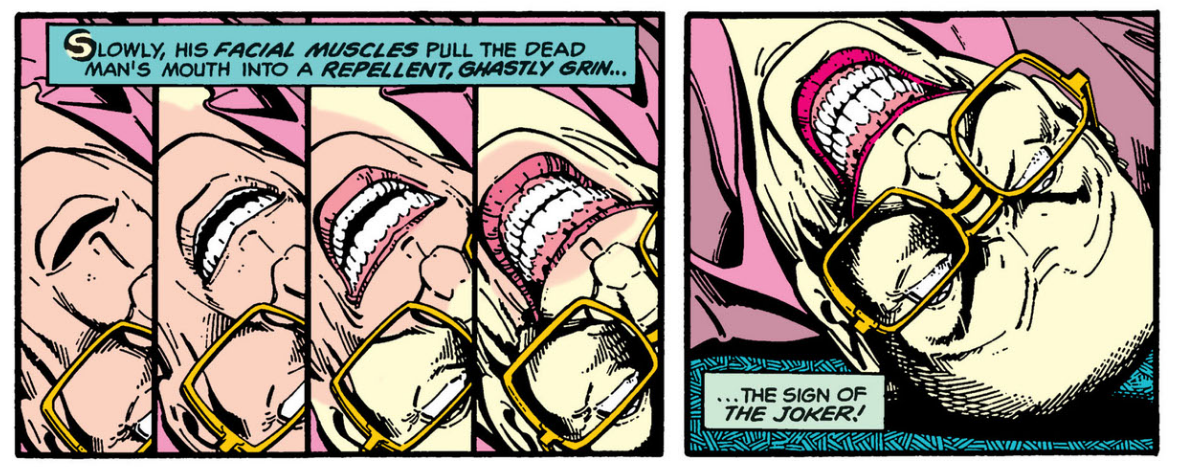
So then he’s even scarier, right? Because he can work it out, he just works it out with all these extra things that nobody else would think of, but it works, so it’s effective, but it’s so weird. That’s his essence, right? That’s all we know about the Joker.
Except that he goes and he tells Boss Thorne to lay off, because Batman’s mine. The Joker’s a wonderful character. He’s got so many aspects. And then Boss Thorne freaks out and runs away, but he runs into Silver, which is extremely improbable, but you know, there it is.
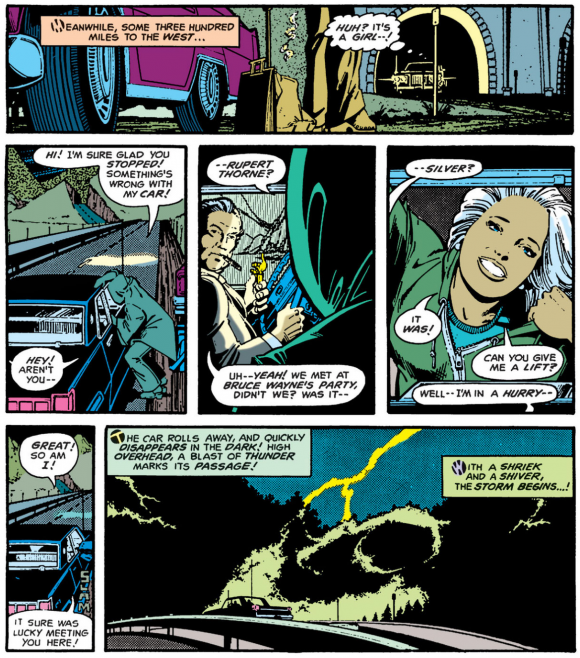
Dan: A chance roadside meeting between these two characters.
Steve: In Ohio or something. This is part and parcel of wrapping all this up. At some point, when you’re doing stories like this, you kind of go, “OK, now we’re headed toward a specific ending.” So people will go with that, I think. They won’t say, “How the fuck did she run into him in Ohio?” It’s like, “Oh yeah, here they come. We know we’re coming together here now. Everything’s all pulling together.”
—
NEXT: DETECTIVE COMICS #476 — The Masterpiece Inside a BATMAN Masterpiece. Click here.
—
MORE
— INSIDE THE BATMAN: THE STEVE ENGLEHART INTERVIEWS Complete INDEX. Click here.
— PART 6: DETECTIVE COMICS #474 — How an Unplanned Issue Became a BATMAN Classic. Click here.

August 8, 2020
One thing I really loved about Englehart’s Joker was that he was extremely funny. Insane & dangerous – yes, but also funny. It’s the humorous aspect that’s often missing and it’s really integral to character.
August 8, 2020
This interview detailing the Joker certainly had me intrigued.
August 9, 2020
The “Joker” film is the best version of the character in my opinion. I disagree with you and Englehart about the character being more interesting the less you know about him. Christopher Nolan said much the same thing about the character around the time of “The Dark Knight,” comparing him to Darth Vader, whom he felt was more interesting when we didn’t know much about his origins. But I’m also someone who thought Vader was pretty two-dimensional and didn’t find him to be particularly interesting until we saw his full character arc in the prequel trilogy.
To me, villains are more compelling when we can see them as the hero of their own story. And seeing the motivations of the character (like Anakin, like Arthur Fleck) humanizes them. Mind you, it doesn’t necessarily make them more sympathetic and it doesn’t excuse their actions, but it makes it less black and white. And an infinite tonal range of gray in a narrative is more interesting to me than just simple binary choice between black or white (which is probably why I also love the Zack Snyder DC films).
August 10, 2020
I’ve got to disagree with you about Vader… I felt like the Original Trilogy gave me just enough information about him to fear him, respect him, and, at the end, pity him. His redemption arc was complete, and somewhat surprising.
I felt like the air was taken out of the character by showing him as a virgin-birthed, messiah, “the one who will bring balance” character who later becomes a completely unlikable whiny brat. It made me sympathize with Anakin/Vader for all the wrong reasons, and later, hate Anakin/Vader for all the wrong reasons as well.
As a kid, there were rumors of how Vader was maimed, the most prevalent was that he battled Obiwan on the edge of a volcano, and fell in, requiring the need for the suit and breathing apparatus. The story differed according to who was telling it. This cloud of mystery created a larger-than-life backstory, and fed into a larger-than-life character. The details were irrelevant, and the prequel trilogy was all details, and therefore, irrelevant.
August 10, 2020
Totally with Tone– Vader was better before we got into specifics, same thing with The Joker– he should have no real name, he should be a force of nature, complete mystery.